The 2017 SXSW Film Festival Offers Another Fine Selection of Movies
Written by: Christopher Llewellyn Reed | March 25th, 2017

The first South by Southwest (SXSW) Festival took place in 1987, and was devoted to music. In 1994, the organizers added two new sections, “Interactive” and “Film.” And here we are, at the 24th iteration of the last two, which happen concurrently, beginning each year’s conference. They start the show on a Friday (this year, March 10), and then Interactive ends in the middle of the following week, just as Music begins. Film and Music then run side-by-side until the second weekend, just before which, now since 2013, an additional section – the Gaming Expo – begins. Suffice it to say that in 2017, from March 10-19, there was quite a lot happening in Austin, Texas, with speakers, technology companies, musicians, filmmakers and many more creatives all rubbing shoulders around the town.
This was my 4th year in attendance, and I saw quite a few good films. I also saw some that I did not like, but I am here to focus primarily on the positive (with a criticism here or there). As it does every year, the festival awards both jury prizes and audience awards, a few of which dovetail with my own choices. What follows is a list of my personal favorites, complete with capsule reviews, ranked within the following three categories: mainstream (i.e., bigger budget, with name stars, probably guaranteed a theatrical release because of who is in it and/or who produced it), specialty (i.e., independent and smaller budget, even with a star or two, that may ultimately end up only online) and documentary. Where I have previously written a full review for Hammer to Nail, the online magazine where I am lead film critic, I indicate such fact within the body of the text. Enjoy!
Mainstream
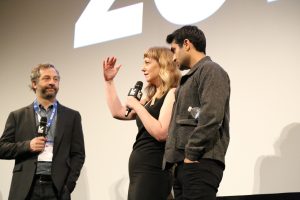
1. The Big Sick (Michael Showalter, 2017)
Co-written by real-life romantic partners Emily V. Gordon (Comedy Central’s The Meltdown with Jonah and Kumail) and Kumail Nanjiani (same show, plus HBO’s Silicon Valley, and many more), The Big Sick is loosely based on the couple’s culturally fraught courtship, in which Nanjiani’s Pakistani Muslim family must come to terms with his love of a non-Muslim white American. Winner of the Audience Award within the “Festival Favorites” category (given to films which premiered elsewhere), and directed by Michael Showalter (Hello, My Name Is Doris), the film is a charming affair, mixing comedy and tragedy (mostly the former) in a manner both droll and poignant. Nanjiani plays himself (or a version thereof), joined by Zoe Kazan (Ruby Sparks) as Emily. Together they have a genuinely sweet chemistry, meeting cute, falling in love almost instantly, then spending the rest of the film battling against the traditional values that get in their way. The title comes from an illness that strikes Emily halfway through, forcing Kumail to reconsider his priorities. Since he’s a stand-up comedian in the movie – as he is in the real world – Kumail deals with life through an acerbic wit that never stops giving, allowing jokes to flow even in a hospital ward. Along for the ride are Holly Hunter (TNT’s Saving Grace) and Ray Romano (CBS’s long-running Everybody Loves Raymond) – who has a lot of fun playing a man unable to tell a joke – as Emily’s parents, along with a deep cast of other talented supporting players. It’s a lovely film, filled with laughter and tears, and a beautiful paean to the relationship at its center.

2. Gemini (Aaron Katz, 2017): the paragraph, below, is an adaptation of a longer review I wrote for Hammer to Nail
A dreamy thriller with a laid-back vibe that is both ode and rebuke to Hollywood and its environs, Aaron Katz’s Gemini starts out as a lazy yarn about a pampered star and her devoted personal assistant and quickly morphs into a gripping police procedural in which the truth is not quite what it seems. Jill (Lola Kirke, Amazon’s Mozart in the Jungle) has long worked for, and been friends with, Heather (Zoë Kravitz, Dope), and their relationship is as much symbiosis as transaction (shades of Olivier Assayas’ 2014 Clouds of Sils Maria). As the movie begins, Heather begs Jill to take her place at a meeting with a director to cancel her role in his movie. We get the sense that this is what Jill always does. But just how far will she go to protect Heather? With a sudden gunshot at the end of the first act, we start to find out, as the police, led by Detective Ahn (John Cho, Star Trek Beyond), show up to investigate. Perfectly directed by Katz (Land Ho!), who subverts our expectations of how a mystery should unfold, the film takes its time winding towards its conclusion. And though that ending, imperfect in its resolution of some of the plot threads, is not quite up to the cinematically juicy build-up that precedes it, the film still offers an overwhelmingly satisfying experience, thanks in large part to Kirke’s mesmerizing central performance, an evocative score from Keegan DeWitt (Hunter Gatherer), and great work by cinematographer Andrew Reed (A Picture of You).
3. Baby Driver (Edgar Wright, 2017)
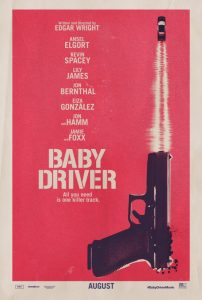
If only the entire movie were as good as its first act, Baby Driver would be a near-masterpiece of dazzling mise-en-scène and editing. Snappy, brisk and wildly inventive in its opening third, the film, from British director Edgar Wright (Hot Fuzz), follows “Baby” (Ansel Elgort, The Fault in Our Stars), a getaway driver for a bank-robbing team headed by the shadowy Doc (Kevin Spacey, Elvis & Nixon). As two men and one woman make their way inside the target, Baby sits in the front seat, jamming to the tunes on his iPod. Wright cuts to the beat, shifting angles and shot sizes in a dizzying display of filmmaking bravura, subsequently upping the ante even more when the gangsters jump back in the vehicle, prompting one of the best car chases to make it to the screen in years (with more to come). Later, Wright shows he can handle blocking, as well as cutting, when his camera pursues Baby on a pedestrian coffee run. Unfortunately, this virtuosity falters midway through, when the script turns maudlin, and for a while we fear that Wright has lost his way. Fortunately, the ending sees him regain his footing, though the final scenes are still a bit soggy. Joining Elgort and Spacey – both excellent – in the madcap mayhem are Jamie Foxx (Django Unchained), Eiza González (El Rey Network’s From Dusk Till Dawn: The Series), Jon Hamm (AMC’s Mad Men), and Lily James (Cinderella), among others in a great supporting cast. If you like your adrenaline rush set to a catchy soundtrack (in many ways, the film feels inspired by Wright’s favorite playlist), and don’t mind the messy middle section, then this could be the film for you.

4. Free Fire (Ben Wheatley, 2017)
Another trippy action movie, Free Fire profiles a gun deal that goes very bad, very quickly. The title refers to the shooting, which starts soon after our cast of characters arrive in the deserted waterfront warehouse where money is to be exchanged for arms. That cast includes Brie Larson (Room), Armie Hammer (The Man from U.N.C.L.E.), Cillian Murphy (In the Heart of the Sea) and Sharlto Copley (Hardcore Henry), among others, bedecked in outfits and hairstyles (including, for the men, facial hair) appropriate to the 1970s setting. As in Baby Driver, there’s a lot of directorial flash here, and Ben Wheatley (High-Rise) keeps things moving in a marvelously kinetic way that belies the single location. If ultimately there is not a lot of there there – beyond the unspoken mantra that violence begets violence – it almost doesn’t matter, since Wheatley tells his story in a frenzy of panache that leads us to laugh at the sadistic excess as each bullet (and there are so many) hits its mark. In many was a nihilistic tour de force, it won’t be for everyone, but it’s mostly good fun for those who like their carnage with a dash of wit.
That’s it for my favorite mainstream releases – just 4 – but in the following category I recommend 6 films, for a total of 10 among the narrative (fiction) movies.
Specialty

1. Easy Living (Adam Keleman, 2017): the paragraph, below, is an adaptation of a longer review I wrote for Hammer to Nail
My favorite film of the festival, director Adam Keleman’s debut feature is a perfect gem of a movie, starring Caroline Dhavernas (NBC’s Hannibal) as Sherry Graham, a door-to-door cosmetics sales agent who lives in a motel. That’s a more than apt metaphor for her inability to settle down and grow up. Physically put together life a pro, Sherry rings doorbells in a baby-blue suit and matching wheeled suitcase, and has a great way with people, especially in these limited interactions; it’s intimacy at which she fails. She’s also an active alcoholic in major denial. As played by the marvelous Dhavernas, Sherry is self-aware to a degree, yet unable to change. Every night, she goes to a bar, once more skipping her AA meeting, and picks up a new man. As sad as Sherry may be, in our eyes, Dhavernas imbues her with a luminosity that shines through the sorrow: it’s the subtle way she portrays someone who is completely off her rocker that is a thing of wonder to behold. At the end, when Sherry finally gets something of a comeuppance, Keleman handles the crisis in a way uniquely his own, making this movie no retread of the cinematic commonplace, but its own fresh and extraordinary object.
2. The Transfiguration (Michael O’Shea, 2016): the paragraph, below, is an adaptation of a longer review I wrote for Hammer to Nail
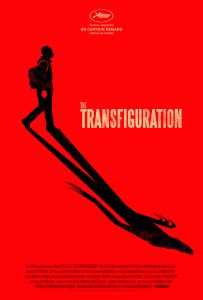
Speaking of the extraordinary, Michael O’Shea’s own debut feature, a vampire drama set in Queens, New York, defied expectations when it was accepted into the 2016 Cannes Film Festival, since O’Shea, a complete unknown, simply submitted it via the ordinary process, without connections. It’s no wonder that festival jumped at the chance to program it, however, since The Transfiguration is a remarkable film that mixes genre fiction with socio-political commentary. Milo (Eric Ruffin, Nature Calls) is small for his age, and lives in the projects, an African-American kid living with his older brother Lewis, an army veteran. Both parents are dead, and the local gang members – former friends of Lewis – tease Milo as a “freak.” Little do they realize how right they are, for even their predatory ways do not include drinking the blood of their victims. Milo, it seems, drowns his sorrows in the blood of others, studying vampirism to better realize his destiny, as he sees it. Is Milo an actual vampire, or just in thrall to the idea? Whatever the truth of that, no one can go long as a butcher of innocents before paying some kind of price. Beautifully directed and shot, The Transfiguration is that marvelous cinematic object: a meditation on action and consequence in which the latter manifests itself in surprising ways, giving us a deeply moving portrait of a killer and his redemption.
3. Hounds of Love (Ben Young, 2016): the paragraph, below, is an adaptation of a longer review I wrote for Hammer to Nail
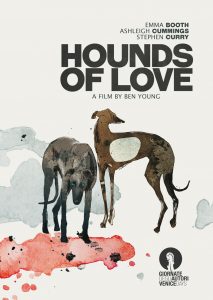
A brutal cinematic experience, Hounds of Love – another debut feature, this one from Australian Ben Young – tells the harrowing (if fictional) tale of a psychotic couple that abducts teenage girls. The time is 1987; the place, Perth, Australia. Filmed in muted sepia-toned colors, the movie immerses us in an atmosphere of sweaty, bloody dread, the grime of which we wash off with difficulty once the story ends. As the film begins, we watch as young women play volleyball, observed from a nearby car. The couple in question – Evelyn and John – wait, and director Young freezes the moment in a pregnant pause of expectation, as the predators stalk their prey. The poor girl to whom they later offer a ride – whose face we never see – will soon find herself chained to a bed, and then dumped in the ground. And then comes Vicki (Ashleigh Cummings, Galore), a teenager unhappy at her parents’ impending divorce who sneaks out one night to a party and is herself captured. She’s a fighter, though, and the wonderful Cummings lets us know that this mark won’t be so easy. As the film proceeds, we’re never sure how far Young will go with the material, alternating between exploitation and empowerment, yet Cummings makes Vicki a worthy protagonist, both fragile and strong, girl and woman. By the end, we are exhausted, wrung out from the stress of watching, yet also elevated by the power of Young’s craft.
4. Fits and Starts (Laura Terruso, 2017): the paragraph, below, is an adaptation of a longer review I wrote for Hammer to Nail

Yet another first feature, from writer/director Laura Terruso (co-writer, Hello, My Name Is Doris, which was based on her own short film, Doris and the Intern), Fits and Starts takes on the pretensions of intellectuals and artists – while simultaneously embracing the importance of both – with witty character sketches that keep us constantly on our toes. David and Jennifer have been married for only a few years, but already their union is showing some strain. They’re both writers, but she has, so far, proved the more commercially successful of the two. As the film opens, David is deep in a nightmare in which he finds himself naked at his own book reading, but when he wakes up to face the day, it’s actually Jennifer who has the scheduled reading. Soon, the couple find themselves invited to a “salon” at the home of Jennifer’s agent. If David can just impress the crowd with a selection from his long-gestating work-in-progress, surely he’ll emerge from his slump. Much of the success of the movie is due the cast. Former The Daily Show writer Wyatt Cenac (Medicine for Melancholy), as David, lends his character a wry, woeful tenor that makes his subsequent pratfalls especially hilarious. Greta Lee (Lucy on Hulu’s Chance), as Jennifer, is the opposite, all kinetic energy and edginess. Together, they make a perfect comedic pair, and help Terruso achieve a very promising debut.
5. The Strange Ones (Christopher Radcliff/Lauren Wolkstein, 2017)
Winner of a Special Jury Recognition for Best Breakthrough Performance, The Strange Ones showcases lead actor James Freedson-Jackson in the role of a young kid on the road with his older brother, running from a murky, as-yet-unexplained tragedy. An adaptation of an earlier short film by the same duo, Christopher Radcliff and Lauren Wolkstein – two of the creative forces behind last year’s omnibus film Collective: Unconscious (he the editor, she one of the five directors) – this elliptical mystery offers a narrative that is sometimes too opaque for its own good, yet filled with genuine cinematic pleasures. Foremost among them is, indeed, the outstanding acting, not only from Freedson-Jackson (young Kilgrave on Netflix’s Jessica Jones) but also from Alex Pettyfer (Magic Mike) as the older brother. Together they huddle as a team against the world, until circumstances separate them and we learn the awful truth behind the central riddle of the plot. Radcliff and Wolkstein prove especially adept at playing with temporal and geographic shifts in the story, manipulating the medium of the moving image – the art of time and space – in a highly satisfying manner. If ultimately not quite up to its full narrative ambitions, The Strange Ones is still a powerful tale of loss and healing.
6. Most Beautiful Island (Ana Asensio, 2017)
The Grand Jury Winner in the Narrative Feature Competition, Most Beautiful Island –yet one more first feature, this time from Spanish actress-turned-director Ana Asensio (The Archive) – starts out slowly as a stark drama about the plight of an immigrant woman in New York, before suddenly becoming, in one great shift, a harrowing thriller about the extremes to which our economic caste system will take us. Asensio, herself, plays Luciana (pronounced with a Spanish “lisp” on the “c”), whose past remains murky, yet whom he see sorrowfully touching baby clothes and talking to her mother on the phone about the reasons for her self-imposed exile from home. Something has brought her to the New World, and so far the journey is a difficult one. When a Russian friend asks that she substitute for her at an evening party where all she will ostensibly have to do is stand around and look pretty, little does Luciana realize that she will soon face a major crisis that will define the kind of person she wants to be. Though at first uneven, both in terms of mise-en-scène and performance, the movie gathers steam and confidence in its second half, becoming a remarkable study in how to successfully marry insightful political commentary and narrative storytelling. Asensio is always watchable, and this mostly assure debut promises good things to come.
That’s it for my favorites among the specialty releases, although I’d also like to mention actor/director Mark Webber’s Flesh and Blood as a worthy runner-up.
Documentary
1. Nobody Speak: Trials of a Free Press (Brian Knappenberger, 2017): the paragraph, below, is an adaptation of a longer review I wrote for Hammer to Nail
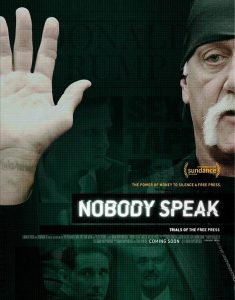
A profound work of investigative journalism and an essential film for our current era, Nobody Speak: Trials of a Free Press focuses primarily on the lawsuit brought by wrestler Hulk Hogan against Gawker Media, in which Hogan (born Terry Bollea) was awarded $140 million in damages, enough of a sum to force that company into bankruptcy. What starts out as a standard documentary procedural, however, soon becomes an exposé on how the rich and powerful in our country are attempting to silence the fourth estate. Hogan, it turns out, was not working on his own. Peter Thiel, a Silicon Valley entrepreneur who years earlier was outed as gay by a Gawker subsidiary, had long nursed a grudge, biding his time until the right moment would arise to kill the company. We can hate much of what Gawker, sleazy online tabloid that it was, did, but still grant that it had every right to publish its stories, and understand that its defeat in court bodes ill for the future of the First Amendment of our Bill of Rights. If a free press is essential to democracy, does this presage a slide towards control of the media by billionaires? Let’s hope not, but based on what we see in Knappenberger’s brilliant, if frightening, movie, it’s a distinct possibility.
2. Kim Dotcom: Caught in the Web (Annie Goldson, 2017): the paragraph, below, is an adaptation of a longer review I wrote for Hammer to Nail (which has yet to post, as of this writing)
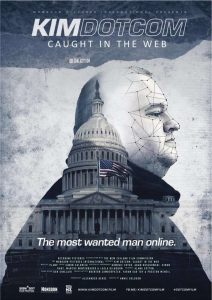
Another brilliant documentary procedural, Kim Dotcom: Caught in the Web is one of those essential documentaries about government overreach – along with movies like Citizenfour, Deep Web and We Steal Secrets: The Story of WikiLeaks – and profiles a flawed protagonist (ethically challenged, shall we say) whose fate, at the hands of law-enforcement agencies within the United States and New Zealand, is disproportionate to his crime. New Zealand Director Annie Goldson (Brother Number One) offers sharp commentary from an array of talking-head experts, including technology writers Greg Sandoval and Sean Gallagher, who take us through the history of Kim Dotcom’s rise and fall. Born Kim Schmitz, in Germany, Mr. Dotcom changed his name as the internet proved his fortune, investing in one scheme after another before achieving massive wealth with the success of his signature site, Megaupload, which allowed users to stream music and videos, thereby provoking the ire of the Hollywood community. When the FBI and its New Zealand equivalent (Dotcom had, by this time, moved to New Zealand) turned out to break many privacy laws in a joint raid on Dotcom’s compound, the subsequent investigation almost brought down the government of John Key, then the Kiwi Prime Minister. It’s a dense story, but Goldson makes it all clear, thanks to a brisk pace and smart narrative choices.
3. Rat Film (Theo Anthony, 2016): the paragraph, below, is an adaptation of a longer review I wrote for Hammer to Nail
An exhaustive, though never exhausting, history of Baltimore City’s relationship with its primary rodent, Rat Film offers a mesmerizing mix of straightforward documentary storytelling and experimental elements. This is Baltimore-based artist Theo Anthony’s debut feature, and he reveals himself a brashly confident filmmaker, never afraid to take creative chances in the pursuit of his narrative vision. I love the way he returns, time and again, to overhead maps of the city that reveal how the zoning decisions made in 1911 – based on racial segregation – have had an enduring impact on poverty, crime and density of rat habitats. Once we learn this, it’s difficult not to wonder at the bureaucratic cruelty of past urban planners whose resolutions have led us here. I also really like the voiceover by Maureen Jones, who serves, throughout, as our audio guide. She speaks in a near monotone, almost as if Anthony had directed her to sound as much like the mechanized voice of Siri as possible, thereby lending simultaneous familiarity and emotional detachment to the proceedings. At the same time, however, there’s a hint of dry wit beneath the surface, as if she and Anthony realize the potential absurdity of this approach. Ultimately, since the subject matter is, in fact, rather grim, this technique, and its attendant dramatic irony, serves the story well. Rat Film is a powerful amalgam of information and art, and I look forward to seeing more work from this filmmaker in the future.

4. Maineland (Miao Wang, 2017): the paragraph, below, is an adaptation of a longer review I wrote for Hammer to Nail (which has yet to post, as of this writing)
In director Miao Wang’s new documentary – the second in a trilogy that began with Beijing Taxi, in 2010 – we follow a group of Chinese teenagers as they come to the United States to study in a private boarding school. These particular students elect to attend Fryeburg Academy, in Maine, which has long played host to foreign nationals (as have many of its peer institutions). To avoid overwhelming the audience with data, Wang chooses two main characters, a boy and a girl, Harry and Stella, each of whom has a very different trajectory over the course of the three years we spend with them. Harry is nerdy and somewhat awkward, while Stella is a social butterfly. We meet them first in China, as they ponder their choices of where to study, and then travel with them to Maine. And so, for three years, we watch them grow. Harry eventually settles in, leaning increasingly towards an international outlook, while Stella, initially so liberated by the American experience, looks homeward for her future, more comfortable with her Chinese peers than she thought she would be. It’s an interesting shift, just one of many surprises in store for the viewer. Over the course of a brisk 90 minutes, Wang weaves a fascinating tale – devoid of traditional documentary talking-head interviews – that profiles the intellectual and social development of two smart and determined individuals.
5. Mommy Dead and Dearest (Erin Lee Carr, 2017)
The second feature-documentary from Erin Lee Carr (Thought Crimes: The Case of the Cannibal Cop), Mommy Dead and Dearest profiles the very odd case of how a mother’s killing by her daughter’s boyfriend – planned by that very same daughter – may not be the evil and unexplainable act it first appears. Young Gypsy Rose Blanchard, a young woman with a long history of documented physical and mental disabilities, could be the real victim here. As the film begins, we are treated first to footage of her childhood, in which she appears sickly and mentally much younger than her actual years. We learn how Gypsy was a cancer survivor and lived with her sweet and loving mother, who devoted herself to her daughter’s well-being. Before long, however, the tale morphs into one of abuse and Munchausen Syndrome by Proxy, that behavioral disorder that leads a primary caretaker to exaggerate and invent symptoms in a child. Suddenly it doesn’t seem so strange that Gypsy, as she grew older, would seek to escape by any means necessary. Still, if there’s a crime, there must be a penalty, and Carr expertly walks us through the details of the case, interviewing all surviving participants, including Gypsy, to create a gripping real-life drama that holds one’s riveted attention throughout.
That’s it for my favorites among the documentaries, although I also really liked Barbecue (Matthew Salleh), The Blood Is at the Doorstep (Erik Ljung), California Dreams (Mike Ott), Dealt (Luke Korem, winner of the Audience Award in the Documentary Feature Competition), I Am Another You (Nanfu Wang, winner of the Special Jury Recognition for Excellence in Documentary Storytelling), Pornocracy: The New Sex Multinationals (Ovidie), Trophy (Shaul Schwarz/Christina Clusiau), Unrest (Jennifer Brea), and The Work (Gethin Aldous/Jairus McLeary, Grand Jury Winner of the Documentary Feature Competition). The difference between how I feel about one film vs. another are negligible, as it was a very strong documentary program, overall.

Overall, this is a great festival to attend, although if you plan to go, it’s important to buy your film badge as soon as they go on sale (in August), as the price increases every month thereafter. Also, if you plan to book a hotel within reasonable distance of downtown Austin, you will need to do so through the official SXSW housing office, and you cannot book a room until you have a badge. Again, the earlier you take care of your travel details, the better. Next year will mark the 25th anniversary of SXSW film, and I plan, once more, to be there. Hope to see you in Austin, as well!


